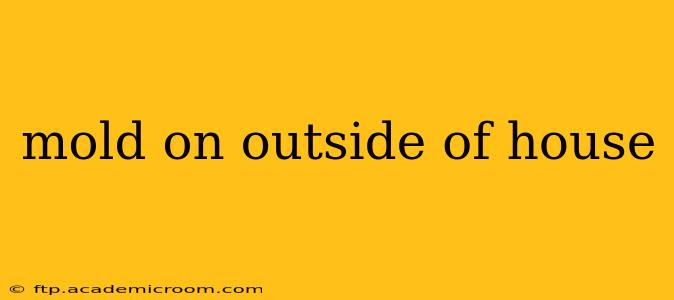Mold growth on the exterior of your house is a common problem, often unsightly and potentially indicative of underlying issues. This comprehensive guide will help you identify, prevent, and remove exterior mold, ensuring the health and longevity of your home.
What Causes Mold to Grow on the Outside of a House?
Moisture is the primary culprit behind exterior mold growth. Several factors contribute to this:
- Rainwater: Prolonged exposure to rain, especially in areas with high humidity, can saturate building materials, providing an ideal breeding ground for mold spores.
- Leaks: Leaking roofs, gutters, or windows can create consistently damp areas, accelerating mold proliferation.
- Poor Drainage: Inadequate drainage around the foundation allows water to pool near the house, increasing the risk of moisture penetration.
- Shading: Areas with limited sunlight remain damp for longer periods, fostering mold growth.
- Building Materials: Certain building materials, like wood and untreated fiber cement, are more susceptible to moisture absorption and mold colonization.
What Types of Mold Are Commonly Found on House Exteriors?
Several mold species thrive in outdoor environments. Identifying the specific type often requires professional testing, but common genera include:
- Cladosporium: This is one of the most prevalent outdoor molds, often appearing as dark, greenish-black patches.
- Alternaria: Another common outdoor mold, Alternaria frequently appears as dark brown or black colonies.
- Aureobasidium: This mold can present as black, brown, or even a slimy, dark olive-green.
Important Note: While many outdoor molds are relatively harmless, some can cause allergic reactions or respiratory problems. It's crucial to avoid direct contact with mold and wear appropriate protective gear during cleanup.
How to Identify Mold on Your House's Exterior
Mold often appears as discolored patches on various surfaces. Common colors include:
- Black: This is a frequent indicator of mold growth, particularly in shaded or consistently damp areas.
- Green: Greenish mold can also signify a significant infestation.
- Brown: Brown patches may indicate mold or other types of organic growth like algae.
Pay close attention to areas prone to moisture accumulation, such as:
- Siding: Look for discoloration, especially near the ground or in poorly ventilated areas.
- Roof: Check for stains or discoloration on the shingles or underlayment.
- Foundation: Examine the foundation for signs of moisture penetration and subsequent mold growth.
How to Prevent Mold Growth on the Outside of Your House
Prevention is key to avoiding costly and time-consuming mold remediation. Here's how:
- Improve Drainage: Ensure proper grading around your foundation, directing water away from the house. Install gutters and downspouts that efficiently channel rainwater away from the building.
- Regular Cleaning: Periodically clean your home's exterior with a solution of water and a mild detergent. Use a pressure washer cautiously, avoiding excessive pressure that could damage the siding.
- Maintain Gutters and Downspouts: Keep gutters and downspouts clean and free of debris to prevent water buildup.
- Roof Maintenance: Regularly inspect your roof for damage and promptly repair leaks to prevent moisture intrusion.
- Proper Ventilation: Ensure adequate ventilation in attics and crawl spaces to reduce moisture accumulation.
How to Remove Mold from the Outside of Your House
Removing mold can be challenging and potentially hazardous, especially for extensive infestations. Consider these options:
- For small areas: Use a stiff brush and a solution of water and bleach (1 part bleach to 10 parts water) to scrub affected areas. Always wear protective gear, including gloves and a mask.
- For larger areas or persistent mold: Consider contacting a professional mold remediation company. They have the expertise and equipment to safely and effectively remove mold, preventing further damage and health risks.
How Much Does Mold Removal Cost on the Exterior of a House?
The cost of mold removal varies significantly depending on the size of the affected area, the type of mold, and the complexity of the remediation process. Minor infestations may be addressed with DIY methods at minimal cost, while larger infestations requiring professional services could cost hundreds or even thousands of dollars.
Is Mold on the Outside of My House Dangerous?
While many exterior molds are not inherently dangerous, they can cause allergic reactions, especially in individuals with sensitivities. Moreover, prolonged exposure to mold can contribute to respiratory problems. The potential health risks depend on the type and amount of mold, and individual susceptibility. If you experience any health issues related to potential mold exposure, consult a medical professional.
Can I Remove Mold Myself, or Should I Hire a Professional?
For small, isolated patches of mold, DIY removal might be feasible. However, for larger infestations or if you suspect significant moisture problems, engaging a professional mold remediation company is strongly recommended. Professionals have the expertise and equipment to safely and effectively remove mold, address underlying moisture issues, and prevent future growth. They also provide necessary documentation, which is helpful if you plan to sell your home in the future.
This guide provides a comprehensive overview of exterior mold. Remember that prevention is the best approach, and consulting a professional is always recommended for significant or recurring mold problems.
